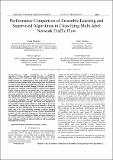Performance Comparison of Ensemble Learning and Supervised Algorithms in Classifying Multi-label Network Traffic Flow

View/
Date
2022-06Author
Machoke, Mwita
Mbelwa, Jimmy
Agbinya, Johnson
Sam, Anael
Metadata
Show full item recordAbstract
Network traffic classification is of significant importance. It helps identify network anomalies and assists in taking measures to avoid them. However, classifying network traffic correctly is a challenging task. This study aims to compare ensemble learning methods with normal supervised classification to come up with improved classification methods. Three types of network traffic were classified (Benign, Malicious, and Outliers). The data were collected experimentally by using Paessler Router Traffic Grapher software and online and were analyzed by R software. The datasets were used to train five supervised models (k-nearest neighbors, mixture discriminant analysis, Naïve Bayes, C5.0 classification model, and regularized discriminant analysis). The models were trained by 70% of the samples and the rest 30% were used for validation. The same samples were used separately in predicting individual accuracy. The results were compared to the ensemble learning models which were built with the use of the same datasets. Among the five supervised classifiers, k-nearest neighbors and C5.0 classification scored the highest accuracy of 0.868 and 0.761. The ensemble learning classifiers Bagging (Random Forest) and Boosting (eXtreme Gradient Boosting) had accuracy of 0.904 and 0.902 respectively. The results show that the ensemble learning method has higher accuracy compared to the normal supervised classifiers. Therefore, it can be used to detect malicious activities in network traffic as well as anomalies with improved accuracy.
